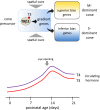Transcriptional control of cone photoreceptor diversity by a thyroid hormone receptor
- PMID: 36454759
- PMCID: PMC9894165
- DOI: 10.1073/pnas.2209884119
Transcriptional control of cone photoreceptor diversity by a thyroid hormone receptor
Abstract
Cone photoreceptor diversity allows detection of wavelength information in light, the first step in color (chromatic) vision. In most mammals, cones express opsin photopigments for sensitivity to medium/long (M, "green") or short (S, "blue") wavelengths and are differentially arrayed over the retina. Cones appear early in retinal neurogenesis but little is understood of the subsequent control of diversity of these postmitotic neurons, because cone populations are sparse and, apart from opsins, poorly defined. It is also a challenge to distinguish potentially subtle differences between cell subtypes within a lineage. Therefore, we derived a Cre driver to isolate individual M and S opsin-enriched cones, which are distributed in counter-gradients over the mouse retina. Fine resolution transcriptome analyses identified expression gradients for groups of genes. The postnatal emergence of gradients indicated divergent differentiation of cone precursors during maturation. Using genetic tagging, we demonstrated a role for thyroid hormone receptor β2 (TRβ2) in control of gradient genes, many of which are enriched for TRβ2 binding sites and TRβ2-regulated open chromatin. Deletion of TRβ2 resulted in poorly distinguished cones regardless of retinal location. We suggest that TRβ2 controls a bipotential transcriptional state to promote cone diversity and the chromatic potential of the species.
Keywords: THRB; color vision; cone photoreceptor; retina; thyroid hormone receptor.
Conflict of interest statement
The authors declare no competing interest.
Figures






Similar articles
-
NeuroD1 regulates expression of thyroid hormone receptor 2 and cone opsins in the developing mouse retina.J Neurosci. 2008 Jan 16;28(3):749-56. doi: 10.1523/JNEUROSCI.4832-07.2008. J Neurosci. 2008. PMID: 18199774 Free PMC article.
-
Distinct functions of photoreceptor cell-specific nuclear receptor, thyroid hormone receptor beta2 and CRX in one photoreceptor development.Invest Ophthalmol Vis Sci. 2002 Nov;43(11):3489-94. Invest Ophthalmol Vis Sci. 2002. PMID: 12407160
-
Retinoid X receptor (gamma) is necessary to establish the S-opsin gradient in cone photoreceptors of the developing mouse retina.Invest Ophthalmol Vis Sci. 2005 Aug;46(8):2897-904. doi: 10.1167/iovs.05-0093. Invest Ophthalmol Vis Sci. 2005. PMID: 16043864
-
Thyroid Hormone Signaling in Retinal Development, Survival, and Disease.Vitam Horm. 2018;106:333-349. doi: 10.1016/bs.vh.2017.05.001. Epub 2017 Jun 19. Vitam Horm. 2018. PMID: 29407441 Review.
-
Loss and gain of cone types in vertebrate ciliary photoreceptor evolution.Dev Biol. 2017 Nov 1;431(1):26-35. doi: 10.1016/j.ydbio.2017.08.038. Epub 2017 Sep 4. Dev Biol. 2017. PMID: 28882401 Review.
Cited by
-
Thyroid hormone-regulated chromatin landscape and transcriptional sensitivity of the pituitary gland.Commun Biol. 2023 Dec 11;6(1):1253. doi: 10.1038/s42003-023-05546-y. Commun Biol. 2023. PMID: 38081939 Free PMC article.
-
Long wavelength-sensing cones of zebrafish retina exhibit multiple layers of transcriptional heterogeneity.Front Cell Neurosci. 2023 Jul 14;17:1214084. doi: 10.3389/fncel.2023.1214084. eCollection 2023. Front Cell Neurosci. 2023. PMID: 37519633 Free PMC article.
-
Expanding the phenotype of THRB: a range of macular dystrophies as the major clinical manifestations in patients with a dominant splicing variant.Front Cell Dev Biol. 2023 Jul 21;11:1197744. doi: 10.3389/fcell.2023.1197744. eCollection 2023. Front Cell Dev Biol. 2023. PMID: 37547476 Free PMC article.
-
Identification of new families and variants in autosomal dominant macular dystrophy associated with THRB.Sci Rep. 2025 Apr 28;15(1):14904. doi: 10.1038/s41598-025-97768-9. Sci Rep. 2025. PMID: 40295579 Free PMC article.
-
Differentiation versus dysfunction: thyroid hormone, deiodinases and retinal photoreceptors.Eur Thyroid J. 2025 Mar 12;14(2):e240315. doi: 10.1530/ETJ-24-0315. Print 2025 Apr 1. Eur Thyroid J. 2025. PMID: 40019772 Free PMC article. Review.
References
-
- Nathans J., The evolution and physiology of human color vision: Insights from molecular genetic studies of visual pigments. Neuron 24, 299–312 (1999). - PubMed
-
- Hunt D. M., Peichl L., S cones: Evolution, retinal distribution, development, and spectral sensitivity. Vis. Neurosci. 31, 115–138 (2014). - PubMed
-
- Roorda A., Williams D. R., The arrangement of the three cone classes in the living human eye. Nature 397, 520–522 (1999). - PubMed
-
- Xiao M., Hendrickson A., Spatial and temporal expression of short, long/medium, or both opsins in human fetal cones. J. Comp. Neurol. 425, 545–559 (2000). - PubMed
Publication types
MeSH terms
Substances
LinkOut - more resources
Full Text Sources
Other Literature Sources
Molecular Biology Databases

